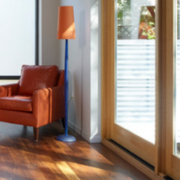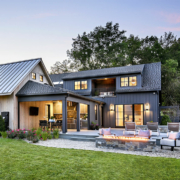DIY Shiplap Accent Wall Installation Guide
You don’t need to be a contractor with decades of experience to install your own shiplap wall… you just need to know the process behind doing it the right way!
Achieving this rustic look, popularized by the tv show Fixer Upper (and often highlighted in This Old House’s Idea House projects) does, however, take a little planning. So, in this easy 10-step tutorial, we break down the process, from start to finish.
For those who require a more visual “how-to,” check out our most recent video—How to Install Shiplap – The Only Tutorial You Need—where we partner with Christy at Oak Hill Millworks for a quick facelift to the accent wall in her own home!
Depending on the size of the wall, plan to dedicate at least an afternoon to the project. Also, you need some knowledge of the basics!
Before you get started, make sure you’re familiar with cutting boards to length and using a jigsaw to notch shapes or curves. If you don’t know how to do this, have someone who DOES on standby to help!
Additionally, it’s beneficial to know the difference between the various products out there on the market. For instance, are you aware of the difference between regular shiplap and nickel gap? Nickel gap is a tongue and groove moulding that has an ⅛” small gap between the front face of the boards. Real shiplap boards, by comparison, do not have tongue and groove and sit flush against one another, accomplishing a 3/8” gap that can be modified to have no reveal, if desired.
Once you have some knowledge and a little bit of experience in your back pocket, you’ll be ready to gather the tools needed to complete your very own DIY shiplap project!
Tools Needed:
- Measuring Tape
- Pencil
- Utility Knife
- Pry Bar
- Stud Finder
- Standard Level
- Jigsaw/Circular Saw
- Miter/Chop Saw
- Pneumatic Nail Gun
- Finishing Nails
- Construction Adhesive
- Caulk Gun
- Paintable Caulk
- Wood Filler
- Putty Knife
Prepping for DIY Shiplap Success – Behind-the-Scenes Work
Step 1: Start by measuring the wall so that you know how much shiplap is needed.
Divide the height of the wall by the width of the shiplap. For example, if you plan to use Baird Brothers’ ¾” x 6” Primed Poplar Shiplap on a standard eight foot wall, divide 96” (8 feet) by 6” (the width of the shiplap moulding).
Step 2: Prep the area by removing everything—pictures, outlet covers, switchplates, and mouldings (crown, baseboard and any door casing)—from the wall. Be extra careful when prying away mouldings that you plan to re-use. Here’s some insight from our friends at This Old House on removing trim.
Remember, sometimes before you build up you have to tear down!
Installing Shiplap Like a Pro (Without Being a Pro)
Step 3: Bump out door jambs with an extension so that, upon completion, your mouldings (casing, baseboard and crown moulding) sit on top of the shiplap and fit snugly to the door jamb. Also, take time to bump out any electrical outlets (but, remember to turn off the power before making adjustments).
*A ¾” extension is needed for doors/outlets if you’re using Baird Brothers’ ¾” x 6” Smooth Face Interior Shiplap. A ½” extension is needed for our ½” x 4” Rough Sawn Interior Shiplap.
Step 4: Next, use a stud finder to locate all vertical studs, since they will be used to fasten the shiplap to the wall when nailing through the face of the boards. Mark the center point of each stud. Then, take a level and mark vertical lines across the length of the wall so that you know where the studs are when securing the shiplap boards.
Step 5: After wall studs are marked, make horizontal level lines with a chalk line or pencil to keep everything in check throughout the installation process. Then, take a measuring tape and, starting at the bottom of the wall, get the measurements for the first board’s cut length.
*Plan to dry fit each piece before applying any adhesive. This will allow for any modifications that may be needed.
Step 6: Once fit is confirmed, it’s time to attach the shiplap to the wall! While some people choose to only nail boards to the studs, you can also glue the backside of the boards with liquid nails prior to installation to achieve an even better hold.
Using finishing nails, hit the center of each stud. Make sure to use two nails per stud (top and bottom) to prevent any natural wood movement or cupping. Starting with the first board, check to make sure everything’s completely level (following along with your pencil or chalk lines). Then, adjust bottom edge spacing with a shim, as needed, for the first board.
Step 7: Measure for any outlets that need to be cut out of the shiplap. A jigsaw will offer a smoother cut that requires less sanding.
Also, for long walls, keep in mind that you want to use variable length boards and stagger the end joints so that there isn’t a visible seam running down the entire height and length of the wall. Baird Brothers proudly offers up to 16’ length options on many of our shiplap species.
Troubleshooting Issues That Might Occur
Keep in mind that not every DIY shiplap install occurs in a newly built home with perfectly smooth drywall! Adjustments may need to happen along the way.
Mouldings can be used to hide minor imperfections with cuts, and wood filler or paintable caulk can make small cracks and gaps disappear. (Hint: Pros love wood filler and paintable caulk!)
The Finishing Touches for Shiplap Walls
Step 8: Once all shiplap has been installed, get to work placing mouldings back where they belong. If you’re reusing old mouldings, clean any previous paint drips/glue from the backside and edges of the mouldings for a snug fit.
Start with the doorways and then install any baseboard and crown (again, attaching to studs and jambs for security).
Step 9: Once everything is back in place, fill any nail holes using wood filler and your putty knife. Let dry and then sand with a fine grit sandpaper.
Finish up the install by running a bead of paintable caulk across any seams or gaps between the shiplap and the mouldings (or between the mouldings and the adjacent walls/ceiling). Follow behind the caulk with a wet cloth and wipe away the excess.
Step 10: When the nail holes have been sanded and the caulking is dry, it’s time to grab your paintbrush. There’s no wrong answer when it comes to colors, because shiplap looks great with nearly any hue!
*Check out this bright blue shiplap accent wall featured in the 2020 Cottage on the Cape Idea House!
Quality Shiplap Boards Make All Difference In DIY
And, there you have it, folks! An easy, 10-step guide to giving your home a quick makeover with minimal effort.
At Baird Brothers Fine Hardwoods, we take great pride in creating the finest hardwood products that both professionals and DIY homeowners can appreciate. Looking for inspiration beyond just installing a shiplap wall in your home?
Check out our site, filled from top to bottom with superior products and unmatched inspiration from our partnership with This Old House and various builders across the nation. We look forward to working with you soon!











